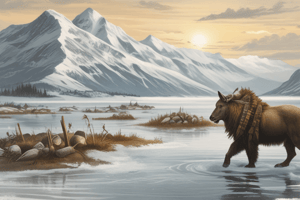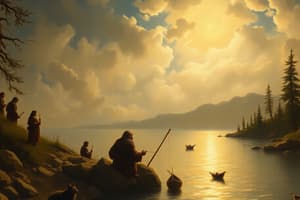Podcast
Questions and Answers
Explain how the Beringia land bridge played a crucial role in the initial settlement of Native Americans in North America.
Explain how the Beringia land bridge played a crucial role in the initial settlement of Native Americans in North America.
The Beringia land bridge, which connected Siberia and Alaska during the last ice age, served as a pathway for the first Native Americans to migrate from Asia to North America. This allowed them to populate the continent over thousands of years.
Discuss the initial reactions of Native American tribes upon encountering European settlers, highlighting both curiosity and caution.
Discuss the initial reactions of Native American tribes upon encountering European settlers, highlighting both curiosity and caution.
Initially, many tribes were curious and fascinated by the Europeans' strange appearances, clothing, and advanced technologies. However, they also exhibited caution, recognizing the potential for disruption and unknown intentions that the newcomers represented to their traditional way of life.
Describe how the perceived threat to expansion influenced white settlers' attitudes and actions towards Native Americans.
Describe how the perceived threat to expansion influenced white settlers' attitudes and actions towards Native Americans.
White settlers viewed Native Americans as obstacles to their westward expansion, leading to policies and actions aimed at displacing or assimilating indigenous peoples to facilitate European-American colonization.
Beyond negative stereotypes, what specific aspects of Native American culture did some white settlers recognize and respect?
Beyond negative stereotypes, what specific aspects of Native American culture did some white settlers recognize and respect?
How did Columbus' geographical miscalculation influence the naming of Native Americans, and what term did he use?
How did Columbus' geographical miscalculation influence the naming of Native Americans, and what term did he use?
Describe how cultural and linguistic barriers affected interactions between Native Americans and European settlers during their early encounters.
Describe how cultural and linguistic barriers affected interactions between Native Americans and European settlers during their early encounters.
How did fear and mistrust, sometimes 'fueled by rumors', impact settlers' interactions with Native Americans?
How did fear and mistrust, sometimes 'fueled by rumors', impact settlers' interactions with Native Americans?
What notable architectural and intellectual achievements characterize the Maya civilization during its Classic period (c. 250–900 CE)?
What notable architectural and intellectual achievements characterize the Maya civilization during its Classic period (c. 250–900 CE)?
Name three of the earliest known Native American cultures in North America, providing their approximate time periods.
Name three of the earliest known Native American cultures in North America, providing their approximate time periods.
In what geographical area did the Olmec civilization flourish, and for what specific cultural contributions are they best known?
In what geographical area did the Olmec civilization flourish, and for what specific cultural contributions are they best known?
Flashcards
Native Americans
Native Americans
Indigenous peoples living in America before European arrival, with settlements dating back over 20,000 years.
Beringia
Beringia
A land bridge connecting Siberia and Alaska, used by early migrants to cross into North America during the last ice age.
Origin of "Indians"
Origin of "Indians"
A term used for Native Americans, originating from Christopher Columbus's mistaken belief that he had reached the Indian subcontinent.
Native American Curiosity
Native American Curiosity
Signup and view all the flashcards
Native American Caution
Native American Caution
Signup and view all the flashcards
Settler Stereotypes
Settler Stereotypes
Signup and view all the flashcards
Settler Intrigue & Fear
Settler Intrigue & Fear
Signup and view all the flashcards
Perceived Threat
Perceived Threat
Signup and view all the flashcards
Olmec Civilization
Olmec Civilization
Signup and view all the flashcards
Maya Civilization
Maya Civilization
Signup and view all the flashcards
Study Notes
- Before European colonization, an estimated 10 million Native Americans inhabited what is now the United States and Canada.
- Evidence suggests Native Americans arrived in America over 20,000 years ago, crossing from Siberia to Alaska via Beringia during the last ice age.
- Early Native American cultures include the Sandia (15,000 BC), Clovis (12,000 BC), and Folsom (8,000 BC) cultures
- Christopher Columbus mistakenly used the term "Indians" for Native Americans, believing he had reached the Indian subcontinent on arrival on October 12, 1492.
First Encounters
- Native Americans were initially curious about the European newcomers arriving in the 16th-17th centuries
- Europeans' strange clothes, beards, and ships were considered marvels
- Native Americans were fascinated with the technology that the newcomers brought
- Caution arose among Native Americans due to the unknown intentions and potential disruption to their way of life
- Misunderstandings and tensions occurred due to cultural and linguistic barriers
White Settler Perceptions
- White settlers often viewed Native Americans through stereotypes and misconceptions, considering them "savages" or "uncivilized"
- White settlers were often intrigued by Native American customs, languages, and ways of life, but also felt superior
- Fear and mistrust were common, particularly where conflicts or violent encounters had occurred
- Westward expansion led white settlers to view Native Americans as obstacles, resulting in policies aimed at displacement or assimilation
- Some white settlers recognized and respected Native American knowledge of the environment, hunting, survival skills, and herbal medicine
Great Civilizations of Ancient Indigenous Peoples of the Americas
- Olmec Civilization: Flourished in present-day Mexico from 1400 to 400 BCE, known for monumental stone heads.
- Maya Civilization: Thrived in present-day Mexico, Guatemala, Belize, Honduras, and El Salvador, peaking during the Classic Period (250-900 CE), and known for advanced astronomy, mathematics, architecture, and hieroglyphic writing.
- Aztec Empire: Centered in the Valley of Mexico, flourished from the 14th to early 16th century CE, accomplished engineers, builders, and warriors.
- Inca Empire: Known as Tawantinsuyu, the largest pre-Columbian empire in the Americas, stretching along the Andes Mountains, known for advanced agricultural terraces and road networks.
- Mississippian Culture: Emerged in the southeastern United States around 800 CE, known for complex chiefdoms and mound-building societies.
Life Before the White Man
- About 10 million Indigenous people lived in what is now the United States and Canada when Europeans arrived.
- The Iroquois: Lived in the northeast, were farmers, and often defeated other tribes in war with over 35,000 people.
- The Sioux and the Cheyenne: Lived in the Great Plains, were nomadic, and relied on buffalo.
- The Pueblo: Lived in present-day Arizona and New Mexico, in villages or towns built for safety and built terraced buildings made of adobe bricks.
- The Apache, Navajo, and Comanche: Never became settled farmers, and moved from the North to the South.
English-Indian Encounters
- In 1607, English settlers established Jamestown.
- Initial hardships included disease and starvation.
- Faced with food shortages by 1610, settlers relied on the Powhatan.
- In 1622 the Powhatan killed 347 white settlers, leading to war.
Thanksgiving
- Thanksgiving origins trace back to a feast shared by the Pilgrims and the Wampanoag in 1621.
- This event symbolized unity, respect, solidarity, and goodwill amid early colonial struggles.
Trail of Tears
- The Trail of Tears was the forced relocation of Native American tribes in the 1830s.
- Native Americans were relocated from the southeastern Unites States to west of the Mississippi River due to the Indian Removal Act of 1830.
- These tribes were forced to travel hundreds of miles on foot in harsh conditions.
- Roughly 4,000 Cherokee and 20,000 from other tribes died.
- 90,000 Native Americans were moved to the new Indian Territory in Kansas, Oklahoma and Nebraska.
Manifest Destiny
- Manifest Destiny was the 19th-century belief in America's right to expand across the continent.
- Westward expansion led to displacement, violence, and loss for Native American tribes.
Little Bighorn and Wounded Knee
- The Battle of Little Bighorn occurred on June 25-26, 1876 and was a clash between the U.S. Army and Lakota Sioux and Northern Cheyenne warriors
- 2,000 Indian warriors killed more than 250 soliders under Custer
- The Wounded Knee Massacre occurred on December 29, 1890 and was a confrontation with the U.S. Army and Lakota Sioux at Wounded Knee Creek
- U.S. soldiers fired indiscriminately upon Lakota men, women, and children, resulting in hundreds of deaths.
Native Americans Today
- Today, Native Americans constitute a diverse population in the United States.
- Native Americans and Alaska Natives are 6.79 million people, 2.09% of the U.S. population
- Many Native Americans live on reservations, which have varying degrees of sovereignty and self-governance.
- Native Americans are U.S. citizens with the same legal protections and civil rights.
- They also have distinct rights stemming from their status as Indigenous peoples.
Famous Quotes
- Geronimo: "I was no chief and never had been, but because I had been more deeply wronged than others, this honor was conferred upon me, and I resolved to prove worthy of the trust."
- Chief Joseph: "Indian respect a brave man, but he despises a coward.......I do not believe that the great spirit chief gave one kind of men the right to tell another kind of men what they must do"......treat all men alike, give them the same law. Give them an even chance to live and grow."
- Crazy Horse: "I salute the light within your eyes where the whole universe dwells. For when you are at that center within you and I am that place within me, we shall be one.”
- Sitting Bull: "Inside of me there are two dogs. One is mean and evil and the other is good and they fight each other all the time. When asked which one wins I answer the one I feed the most."
- Sitting Bull: "For us, warriors are not what you think of as warriors. The warrior is not someone who fights, because no one has the right to take another life. The warrior for us is one who sacrifices himself for the good of others. His task is to take care of the elderly, the defenseless, those who cannot provide for themselves, and above all, the children, the future of humanity."
Studying That Suits You
Use AI to generate personalized quizzes and flashcards to suit your learning preferences.
Related Documents
Description
Examine the Beringia land bridge's role in Native American settlement. Explore initial Native American reactions to European settlers, balancing curiosity with caution. Analyze how expansionist threats shaped settlers' attitudes and actions towards Native Americans. Uncover aspects of Native American culture that garnered recognition and respect from some settlers.




